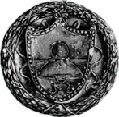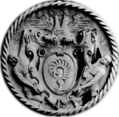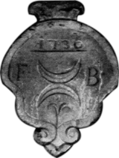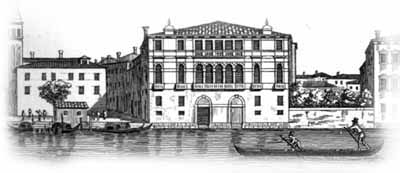
The Malipieros'family tree

The Cappello coat-of-arms

The Malipiero coat-of-arms

The Barnabo coat-of-arms
|

Malipiero Palace
(engraving)
The
history of the Cà Grande of Saint Samuel
The Cà Grande (big palace) of Saint
Samuel was probably built
at the beginning of the 11th century by Soranzo family,
which also built in that period, together with the Boldù family,
the church of St. Samuel facing the Palace. In the 13th century a floor
was added to the
pre-existing bizantyne style' building, in accordance with to
the custom at the time.
In the early days of the 15th century the Cappello
family, one of the most energetic and industrious families of
Venice, bacame owners of the Palace as a result of marriages with the Soranzos.
As from the mid-16th century the Cappello enlarged the building and conferred
to the facade on the Grand Canal its present shape.
Around the 1590 the Malipiero family became tenants of the Cappellos
and Caterino Malipiero, within few years as from 1610,
through the marriage with Elisabetta Cappello and further
purchases, obtained ownership of the whole edifice.
Evidence of the very many restorations done by him are the date 1622
and the initials K.M. (Caterino Malipiero) in an engraving placed over
on the main door he built, giving access to the new large entrance
of the Palace.
Around the year 1725, the Malipiero began new massive restoration
works that gave the palace today's homogeneous aspect.
In the first half of the 19th century,
with the Venetian Republic in full decline and after four centuries
of successions, the Palace of the Soranzos, Cappellos and Malipieros
suffered the same destiny as many other palaces of Venetian
patrician families: passing from hand to hand as a result
of many transfers.
These transfers accelerated the decline of the building until
the Barnabò family purchased it. In 1951 the Barnabòs
undertook a substantial restoration, returning the palace premises
to a grand and serene eighteenth-century style.
The
Cà Grande and the venetian
culture
Very little information could be collected as to the events
that took place in the Palace. However, it appears that
the Cappello family put the palace's storehouses to good use
by developing the newly discovered printing and publishing
activity there.
What we know is that between 1656 and 1676, as a result
of the construction of two very popular and successful
theatres, a licentious way of life spread all over St.
Samuel parish, and soon infected the palace.
We also know that Giacomo Casanova, who was born on Calle della
Commedia (later renamed Calle Malipiero), from 1740 frequented Palazzo
Malipiero assiduously, as a confidant of Senator Alvise II "Gasparo" Malipiero.
Here he established relationships with some influential persons
and with a great many ladies. But one day the Senator caught him with
Teresa Imer, on whom the Senator himself had invested some illusions,
and Casanova was expelled from the Palace and later from Venice.
Casanova left a lively portrait of Alvise II in his
Memoires. The latter work is historically meaningful due to its portrait of
the Venetian custom in the 18th century. In this bizarre and turbulent
environment, the Malipiero suffered a passive decadent demise.
St. Samuel parish cultural life was revived only after 1950 when
the Palazzo Grassi Cultural Center was established.
Palazzo Malipiero also contributes to Venice's Cultural heritage revival
by hosting the exhibition spaces of Studio d'Arte Barnabò Gallery and
Il Tridente Multimedia Publishing
House.
Malipiero Palace also contributed to this by hosting the Barnaḅ Art Studio since 1982; the headquarters of the publishing house of multimedia products Il Tridente and since the 2000s also the exhibition spaces dedicated to the Biennali d'Arte e d'Architettura di Venezia.
Since 2020, together with the Barnaḅ Family's Archive, the building is hosting the 'Hon. Prof. Gianni De Michelis' House and Archive' -then Italian Republic's Minister of Foreign Affairs between year 1989 and 1992-.
A summarized bibliography and
the credits are available here.
|